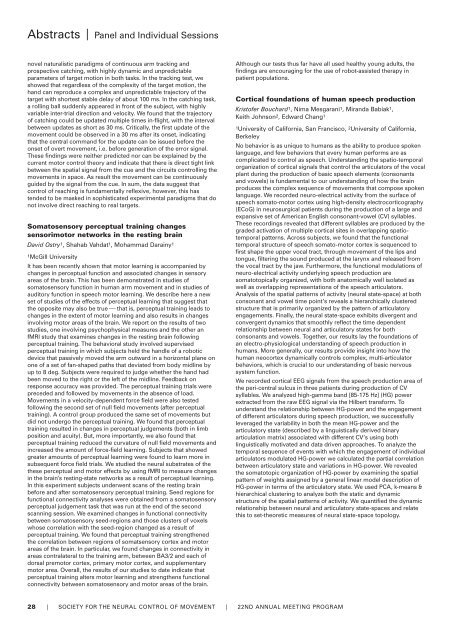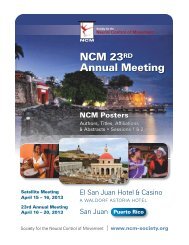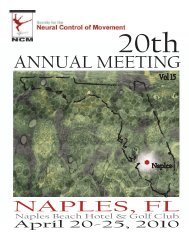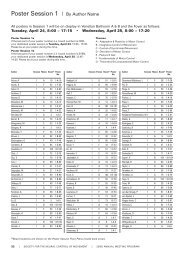2012 Program - Society for the Neural Control of Movement
2012 Program - Society for the Neural Control of Movement
2012 Program - Society for the Neural Control of Movement
You also want an ePaper? Increase the reach of your titles
YUMPU automatically turns print PDFs into web optimized ePapers that Google loves.
Abstracts | Panel and Individual Sessions<br />
novel naturalistic paradigms <strong>of</strong> continuous arm tracking and<br />
prospective catching, with highly dynamic and unpredictable<br />
parameters <strong>of</strong> target motion in both tasks. In <strong>the</strong> tracking test, we<br />
showed that regardless <strong>of</strong> <strong>the</strong> complexity <strong>of</strong> <strong>the</strong> target motion, <strong>the</strong><br />
hand can reproduce a complex and unpredictable trajectory <strong>of</strong> <strong>the</strong><br />
target with shortest stable delay <strong>of</strong> about 100 ms. In <strong>the</strong> catching task,<br />
a rolling ball suddenly appeared in front <strong>of</strong> <strong>the</strong> subject, with highly<br />
variable inter-trial direction and velocity. We found that <strong>the</strong> trajectory<br />
<strong>of</strong> catching could be updated multiple times in-flight, with <strong>the</strong> interval<br />
between updates as short as 30 ms. Critically, <strong>the</strong> first update <strong>of</strong> <strong>the</strong><br />
movement could be observed in a 30 ms after its onset, indicating<br />
that <strong>the</strong> central command <strong>for</strong> <strong>the</strong> update can be issued be<strong>for</strong>e <strong>the</strong><br />
onset <strong>of</strong> overt movement, i.e. be<strong>for</strong>e generation <strong>of</strong> <strong>the</strong> error signal.<br />
These findings were nei<strong>the</strong>r predicted nor can be explained by <strong>the</strong><br />
current motor control <strong>the</strong>ory and indicate that <strong>the</strong>re is direct tight link<br />
between <strong>the</strong> spatial signal from <strong>the</strong> cue and <strong>the</strong> circuits controlling <strong>the</strong><br />
movements in space. As result <strong>the</strong> movement can be continuously<br />
guided by <strong>the</strong> signal from <strong>the</strong> cue. In sum, <strong>the</strong> data suggest that<br />
control <strong>of</strong> reaching is fundamentally reflexive, however, this has<br />
tended to be masked in sophisticated experimental paradigms that do<br />
not involve direct reaching to real targets.<br />
Somatosensory perceptual training changes<br />
sensorimotor networks in <strong>the</strong> resting brain<br />
David Ostry1, Shahab Vahdat1, Mohammad Darainy1 1McGill University<br />
It has been recently shown that motor learning is accompanied by<br />
changes in perceptual function and associated changes in sensory<br />
areas <strong>of</strong> <strong>the</strong> brain. This has been demonstrated in studies <strong>of</strong><br />
somatosensory function in human arm movement and in studies <strong>of</strong><br />
auditory function in speech motor learning. We describe here a new<br />
set <strong>of</strong> studies <strong>of</strong> <strong>the</strong> effects <strong>of</strong> perceptual learning that suggest that<br />
<strong>the</strong> opposite may also be true ⎯ that is, perceptual training leads to<br />
changes in <strong>the</strong> extent <strong>of</strong> motor learning and also results in changes<br />
involving motor areas <strong>of</strong> <strong>the</strong> brain. We report on <strong>the</strong> results <strong>of</strong> two<br />
studies, one involving psychophysical measures and <strong>the</strong> o<strong>the</strong>r an<br />
fMRI study that examines changes in <strong>the</strong> resting brain following<br />
perceptual training. The behavioral study involved supervised<br />
perceptual training in which subjects held <strong>the</strong> handle <strong>of</strong> a robotic<br />
device that passively moved <strong>the</strong> arm outward in a horizontal plane on<br />
one <strong>of</strong> a set <strong>of</strong> fan-shaped paths that deviated from body midline by<br />
up to 8 deg. Subjects were required to judge whe<strong>the</strong>r <strong>the</strong> hand had<br />
been moved to <strong>the</strong> right or <strong>the</strong> left <strong>of</strong> <strong>the</strong> midline. Feedback on<br />
response accuracy was provided. The perceptual training trials were<br />
preceded and followed by movements in <strong>the</strong> absence <strong>of</strong> load.<br />
<strong>Movement</strong>s in a velocity-dependent <strong>for</strong>ce field were also tested<br />
following <strong>the</strong> second set <strong>of</strong> null field movements (after perceptual<br />
training). A control group produced <strong>the</strong> same set <strong>of</strong> movements but<br />
did not undergo <strong>the</strong> perceptual training. We found that perceptual<br />
training resulted in changes in perceptual judgements (both in limb<br />
position and acuity). But, more importantly, we also found that<br />
perceptual training reduced <strong>the</strong> curvature <strong>of</strong> null field movements and<br />
increased <strong>the</strong> amount <strong>of</strong> <strong>for</strong>ce-field learning. Subjects that showed<br />
greater amounts <strong>of</strong> perceptual learning were found to learn more in<br />
subsequent <strong>for</strong>ce field trials. We studied <strong>the</strong> neural substrates <strong>of</strong> <strong>the</strong><br />
<strong>the</strong>se perceptual and motor effects by using fMRI to measure changes<br />
in <strong>the</strong> brain’s resting-state networks as a result <strong>of</strong> perceptual learning.<br />
In this experiment subjects underwent scans <strong>of</strong> <strong>the</strong> resting brain<br />
be<strong>for</strong>e and after somatosensory perceptual training. Seed regions <strong>for</strong><br />
functional connectivity analyses were obtained from a somatosensory<br />
perceptual judgement task that was run at <strong>the</strong> end <strong>of</strong> <strong>the</strong> second<br />
scanning session. We examined changes in functional connectivity<br />
between somatosensory seed-regions and those clusters <strong>of</strong> voxels<br />
whose correlation with <strong>the</strong> seed-region changed as a result <strong>of</strong><br />
perceptual training. We found that perceptual training streng<strong>the</strong>ned<br />
<strong>the</strong> correlation between regions <strong>of</strong> somatsensory cortex and motor<br />
areas <strong>of</strong> <strong>the</strong> brain. In particular, we found changes in connectivity in<br />
areas contralateral to <strong>the</strong> training arm, between BA3/2 and each <strong>of</strong><br />
dorsal premotor cortex, primary motor cortex, and supplementary<br />
motor area. Overall, <strong>the</strong> results <strong>of</strong> our studies to date indicate that<br />
perceptual training alters motor learning and streng<strong>the</strong>ns functional<br />
connectivity between somatosensory and motor areas <strong>of</strong> <strong>the</strong> brain.<br />
Although our tests thus far have all used healthy young adults, <strong>the</strong><br />
findings are encouraging <strong>for</strong> <strong>the</strong> use <strong>of</strong> robot-assisted <strong>the</strong>rapy in<br />
patient populations.<br />
Cortical foundations <strong>of</strong> human speech production<br />
Krist<strong>of</strong>er Bouchard1, Nima Mesgarani1, Miranda Babiak1, Keith Johnson2, Edward Chang1 1University <strong>of</strong> Cali<strong>for</strong>nia, San Francisco, 2University <strong>of</strong> Cali<strong>for</strong>nia,<br />
Berkeley<br />
No behavior is as unique to humans as <strong>the</strong> ability to produce spoken<br />
language, and few behaviors that every human per<strong>for</strong>ms are as<br />
complicated to control as speech. Understanding <strong>the</strong> spatio-temporal<br />
organization <strong>of</strong> cortical signals that control <strong>the</strong> articulators <strong>of</strong> <strong>the</strong> vocal<br />
plant during <strong>the</strong> production <strong>of</strong> basic speech elements (consonants<br />
and vowels) is fundamental to our understanding <strong>of</strong> how <strong>the</strong> brain<br />
produces <strong>the</strong> complex sequence <strong>of</strong> movements that compose spoken<br />
language. We recorded neuro-electrical activity from <strong>the</strong> surface <strong>of</strong><br />
speech somato-motor cortex using high-density electrocorticography<br />
(ECoG) in neurosurgical patients during <strong>the</strong> production <strong>of</strong> a large and<br />
expansive set <strong>of</strong> American English consonant-vowel (CV) syllables.<br />
These recordings revealed that different syllables are produced by <strong>the</strong><br />
graded activation <strong>of</strong> multiple cortical sites in overlapping spatiotemporal<br />
patterns. Across subjects, we found that <strong>the</strong> functional<br />
temporal structure <strong>of</strong> speech somato-motor cortex is sequenced to<br />
first shape <strong>the</strong> upper vocal tract, through movement <strong>of</strong> <strong>the</strong> lips and<br />
tongue, filtering <strong>the</strong> sound produced at <strong>the</strong> larynx and released from<br />
<strong>the</strong> vocal tract by <strong>the</strong> jaw. Fur<strong>the</strong>rmore, <strong>the</strong> functional modulations <strong>of</strong><br />
neuro-electrical activity underlying speech production are<br />
somatotopically organized, with both anatomically well isolated as<br />
well as overlapping representations <strong>of</strong> <strong>the</strong> speech articulators.<br />
Analysis <strong>of</strong> <strong>the</strong> spatial patterns <strong>of</strong> activity (neural state-space) at both<br />
consonant and vowel time point’s reveals a hierarchically clustered<br />
structure that is primarily organized by <strong>the</strong> pattern <strong>of</strong> articulatory<br />
engagements. Finally, <strong>the</strong> neural state-space exhibits divergent and<br />
convergent dynamics that smoothly reflect <strong>the</strong> time dependent<br />
relationship between neural and articulatory states <strong>for</strong> both<br />
consonants and vowels. Toge<strong>the</strong>r, our results lay <strong>the</strong> foundations <strong>of</strong><br />
an electro-physiological understanding <strong>of</strong> speech production in<br />
humans. More generally, our results provide insight into how <strong>the</strong><br />
human neocortex dynamically controls complex, multi-articulator<br />
behaviors, which is crucial to our understanding <strong>of</strong> basic nervous<br />
system function.<br />
We recorded cortical EEG signals from <strong>the</strong> speech production area <strong>of</strong><br />
<strong>the</strong> peri-central sulcus in three patients during production <strong>of</strong> CV<br />
syllables. We analyzed high-gamma band [85-175 Hz] (HG) power<br />
extracted from <strong>the</strong> raw EEG signal via <strong>the</strong> Hilbert trans<strong>for</strong>m. To<br />
understand <strong>the</strong> relationship between HG-power and <strong>the</strong> engagement<br />
<strong>of</strong> different articulators during speech production, we successfully<br />
leveraged <strong>the</strong> variability in both <strong>the</strong> mean HG-power and <strong>the</strong><br />
articulatory state (described by a linguistically derived binary<br />
articulation matrix) associated with different CV’s using both<br />
linguistically motivated and data driven approaches. To analyze <strong>the</strong><br />
temporal sequence <strong>of</strong> events with which <strong>the</strong> engagement <strong>of</strong> individual<br />
articulators modulated HG-power we calculated <strong>the</strong> partial correlation<br />
between articulatory state and variations in HG-power. We revealed<br />
<strong>the</strong> somatotopic organization <strong>of</strong> HG-power by examining <strong>the</strong> spatial<br />
pattern <strong>of</strong> weights assigned by a general linear model description <strong>of</strong><br />
HG-power in terms <strong>of</strong> <strong>the</strong> articulatory state. We used PCA, k-means &<br />
hierarchical clustering to analyze both <strong>the</strong> static and dynamic<br />
structure <strong>of</strong> <strong>the</strong> spatial patterns <strong>of</strong> activity. We quantified <strong>the</strong> dynamic<br />
relationship between neural and articulatory state-spaces and relate<br />
this to set-<strong>the</strong>oretic measures <strong>of</strong> neural state-space topology.<br />
28 | SOCIETY FOR THE NEURAL CONTROL OF MOVEMENT | 22ND ANNUAL MEETING PROGRAM










